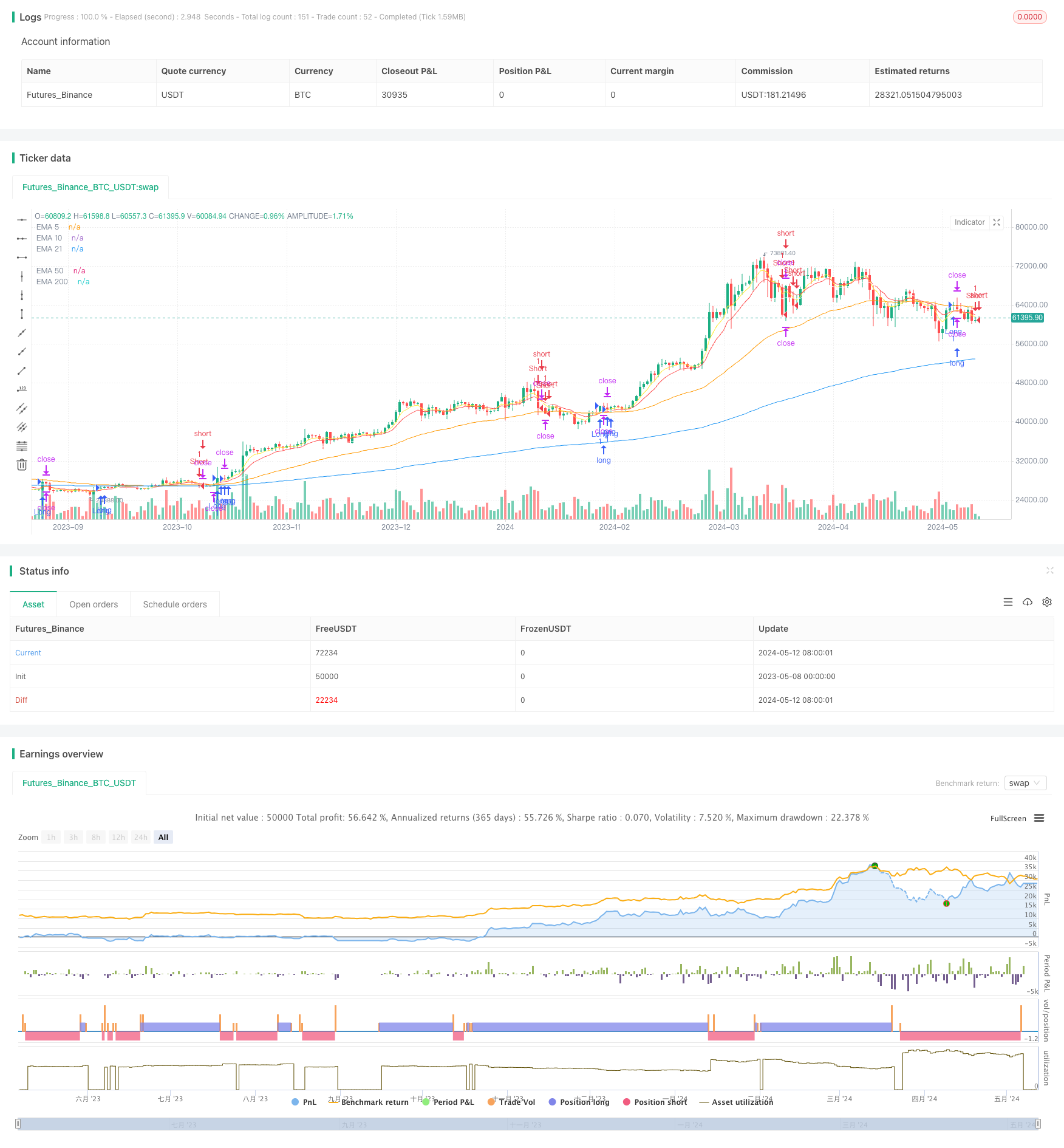
概述
该策略结合了指数移动平均线(EMA)、移动平均线收敛发散指标(MACD)和相对强弱指标(RSI),通过三重指标的共同确认,识别潜在的趋势变化和动量转折点,以提高交易的准确性和可靠性。该策略使用了多个不同周期的EMA(5、10、21、50、200和1000),以全面评估不同时间尺度下的价格趋势。同时,MACD和RSI指标用于确认EMA交叉信号,提供进一步的趋势和动量证据。
策略原理
- EMA交叉:当较短周期EMA(如9日)穿过较长周期EMA(如21日)时,表明潜在趋势变化。多头交叉(9日EMA上穿21日EMA)预示看涨趋势,空头交叉(9日EMA下穿21日EMA)预示看跌趋势。
- MACD确认:利用MACD信号确认EMA交叉。对于多头交易,寻找MACD线上穿信号线且MACD柱状图为正值的情况。对于空头交易,则寻找相反的情况。当MACD柱状图平缓或缺乏明确方向时,避免交易。
- RSI确认:结合EMA和MACD信号,利用RSI确认超买或超卖状况。在看涨情景下,当RSI达到超买水平(>70)时考虑获利了结或平仓多头头寸。在看跌情景下,当RSI达到超卖水平(<30)时考虑获利了结或平仓空头头寸。
优势分析
- 多重指标确认:通过结合EMA、MACD和RSI,该策略提供了更全面可靠的交易信号,减少了假信号的可能性。
- 趋势跟踪:使用不同周期的EMA有助于识别不同时间尺度下的价格趋势,捕捉主要的市场走向。
- 动量衡量:MACD和RSI指标提供了对价格动量的额外洞见,帮助评估趋势强度和潜在反转。
- 风险管理:设置止损单和适当的仓位规模有助于管理风险,限制潜在损失。
风险分析
- 滞后性:作为趋势跟踪指标,EMA可能存在一定的滞后性,导致错过早期趋势变化。
- 假信号:尽管采用了多重指标确认,但在震荡市场条件下仍可能产生假信号。
- 参数优化:策略效果可能对指标参数选择敏感,需要根据不同市场和资产进行优化调整。
- 市场风险:任何交易策略都无法完全消除市场风险,意外事件和黑天鹅事件可能导致重大损失。
优化方向
- 动态参数调整:根据市场状况的变化,动态调整EMA、MACD和RSI的参数设置,以适应不同的市场阶段和波动水平。
- 多时间框架分析:结合多个时间框架的信号,如日线、4小时线和1小时线,以获得更全面的市场视角和确认。
- 风险管理优化:优化止损和止盈策略,如使用移动止损或基于波动率的止损,以更好地保护利润和限制损失。
- 组合其他指标:考虑纳入其他技术指标或基本面因素,如布林带、成交量或市场情绪指标,以提高信号质量和可靠性。
总结
EMA、MACD、RSI三重指标动量策略通过结合多个技术指标的优势,提供了一种全面的交易方法,帮助交易者以更高的置信度识别潜在的趋势变化和动量转折点。该策略利用不同周期的EMA评估多个时间尺度下的价格趋势,并用MACD和RSI指标进一步确认交易信号。尽管该策略展现了优势,但仍存在滞后性、假信号和市场风险等潜在风险。通过动态参数调整、多时间框架分析、风险管理优化和组合其他指标等方法,可以进一步提升策略的性能和稳健性。然而,任何交易策略在实施前都需要全面的回测和评估,并根据个人交易风格和风险承受能力进行适当调整。
策略源码
/*backtest
start: 2023-05-08 00:00:00
end: 2024-05-13 00:00:00
period: 1d
basePeriod: 1h
exchanges: [{"eid":"Futures_Binance","currency":"BTC_USDT"}]
*/
//@version=5
strategy("2024", overlay=true)
// Define additional EMAs
ema5 = ta.ema(close, 5)
ema21 = ta.ema(close, 21)
ema10 = ta.ema(close, 10)
ema50 = ta.ema(close, 50)
ema200 = ta.ema(close, 200)
ema1000 = ta.ema(close, 1000)
// RSI
rsiValue = ta.rsi(close, 14)
// MACD
[macdLine, signalLine, histLine] = ta.macd(close, 12, 26, 9)
// Signal conditions
longCondition = close > ema21 and rsiValue > 50 and histLine > 0
shortCondition = close < ema21 and rsiValue < 50 and histLine < 0
// Entry and exit signals
if (longCondition and strategy.position_size <= 0)
strategy.entry("Long", strategy.long)
strategy.exit("Long Exit", "Long", limit=close*1.02, stop=close*0.98)
alert('7345642438869,buy,XAUUSDm,risk=0.01,sl=140,tp=350', alert.freq_once_per_bar_close)
if (shortCondition and strategy.position_size >= 0)
strategy.entry("Short", strategy.short)
strategy.exit("Short Exit", "Short", limit=close*0.98, stop=close*1.02)
alert('7345642438869,sell,XAUUSDm,risk=0.01,sl=140,tp=350', alert.freq_once_per_bar_close)
// Plotting EMAs
plot(ema5, color=color.yellow, title="EMA 5")
plot(ema10, color=color.red, title="EMA 10")
plot(ema21, color=color.white, title="EMA 21")
plot(ema50, color=color.orange, title="EMA 50")
plot(ema200, color=color.blue, title="EMA 200")
plot(ema1000, color=color.gray, title="EMA 1000")
// Plotting signals
plotshape(longCondition and strategy.position_size <= 0, style=shape.arrowup, location=location.belowbar, color=color.green, size=size.small)
plotshape(shortCondition and strategy.position_size >= 0, style=shape.arrowdown, location=location.abovebar, color=color.red, size=size.small)
相关推荐